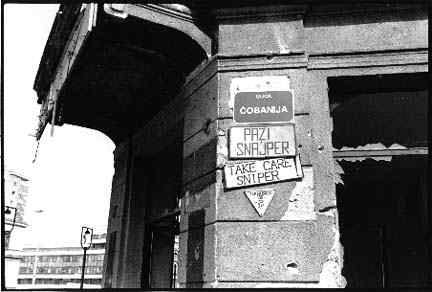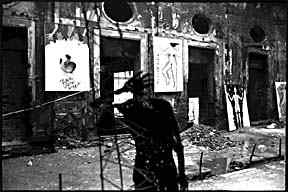




 |
 |
 |
 |
 |
|
| Contents Forward Backwards |
|
What most wartime visitors to Sarajevo found so inexplicable was how life and death issues were dealt with in such matter-of-fact ways. One sees "Sniper" signs in Sarajevo like we would see "Beware, Dog" signs in the United States. (There are also many "Beware, Dog" signs in Sarajevo.) If there is one question that every visitor to Sarajevo asks, it is, "How could you spend years in a basement shelter with no heat, living on rice, risking your life, and dodging snipers to get water, yet sit here now and sip Turkish coffee and smoke cigarettes as if nothing happened?" The usual response is a shrug of the shoulders. The truth is, they weren't asked. They had no choice. While bullets and mortars were raining death on Sarajevo, people still polished their shoes, put on makeup, and attended Beethoven concerts. The photo to the right is of an art exhibit in the destroyed historic postal building in Sarajevo. The exhibit was part of the 12th Sarajevo Winter Arts Festival that began with the Winter Olympics in 1984 and continued every year right through the war. The postal building was destroyed in the first month of the war, severing communication with the outside world. Satellite telephones became the only method of telecommunications in and out of Sarajevo and international aid workers became the only method of mail delivery. |
  |